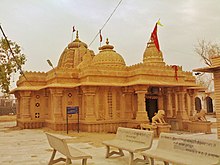
Bharat Mata is a national personification of India (Bharat) as a mother goddess. Bharat Mata is commonly depicted dressed in a red or saffron-coloured sari and holding a national flag; she sometimes stands on a lotus and is accompanied by a lion.
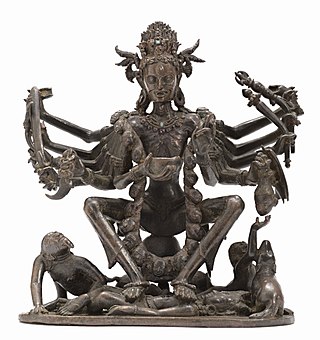
Chamunda, also known as Chamundeshwari, Chamundi or Charchika, is a fearsome form of Chandi, the Hindu mother goddess, Mahadevi and is one of the seven Matrikas.

Tripura Sundari, also known as Rajarajeshvari, Shodashi, Kamakshi, and Lalita, is a Hindu goddess, revered primarily within the Shaktism tradition and recognized as one of the ten Mahavidyas. She embodies the essence of the supreme goddess Mahadevi. Central to the Shakta texts, she is widely praised in the Lalita Sahasranama and Saundarya Lahari. In the Lalitopakhyana of the Brahmanda Purana, she is referred to as Adi Parashakti.
The Kalika Purana, also called the Kali Purana, Sati Purana or Kalika Tantra, is one of the eighteen minor Puranas (Upapurana) in the Shaktism tradition of Hinduism. The text was likely composed in Assam or Cooch Behar region of India and is attributed to the sage Markandeya. It exists in many versions, variously organized in 90 to 93 chapters. The surviving versions of the text are unusual in that they start abruptly and follow a format not found in either the major or minor Purana-genre mythical texts of Hinduism. Various types of animal sacrifices for devi are detailed in the Purana.
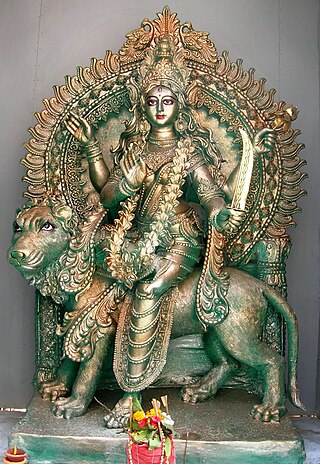
Katyayani (कात्यायनी) is an aspect of Mahadevi and the slayer of the tyrannical demon Mahishasura. She is the sixth among the Navadurgas, the nine forms of Hindu goddess Durga who are worshipped during the festival of Navaratri. She is depicted with four, ten or eighteen hands. This is the second name given to the goddess Adi Parashakti in Amarakosha, the Sanskrit lexicon.

Kanaka Durga Temple, officially known as Sri Durga Malleswara Swamyvarla Devasthanam, is a Hindu temple dedicated to Kanaka Durga. The deity in this temple is also popularly referred as Kanaka Durga. The temple is located in Vijayawada, Andhra Pradesh, India on the Indrakeeladri hill on the banks of Krishna River. Kaalika Purana, Durgaa Sapthashati and other Vedic literature have mentioned about Kanaka Durga on the Indrakeelaadri and have described the deity as Swayambhu, (self-manifested) in Triteeya Kalpa.

Shree Tulaja Bhavani Temple is a Hindu temple dedicated to goddess Bhavani. It is located in Tuljapur in Dharashiv district of Maharashtra, India, and is considered as one of the 51 Shakti Pithas. It is situated 45 km from Solapur. The temple was built in 12th century CE by Maratha Mahamandaleshwara Māradadeva of the Kadamb dynasty.

Dadhichi, also rendered Dadhyanga and Dadhyancha, is a sage in Hinduism. He is best known for his sacrifice in the Puranas, where he gives up his life so that his bones could be used to manufacture the Vajra, the diamond-like celestial thunderbolt of the deity Indra, in order to slay Vritra.
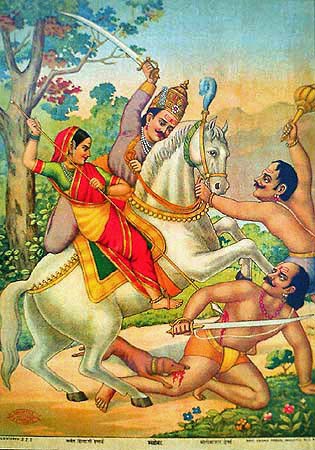
Mhalsa, also spelled as Mhalasa or Mahalasa, is a Hindu goddess. Mhalsa is worshipped as the consort of the folk god Khandoba, a form of the god Shiva. In this tradition, she is associated with Parvati, Shiva's wife.

Hinglaj Mata, also known as Hinglaj Devi, Hingula Devi and Nani Mandir, is a Hindu temple in Hinglaj, a town on the Makran coast in the Lasbela district of Balochistan, and is the middle of the Hingol National Park. It is one of the 51 Shakti Peethas in Shaktism denomination of Hinduism. It is one of the two Shakti Peethas in Pakistan, the other one being Sharada Peeth. It is a form of Durga or Devi in a mountain cavern on the banks of the Hingol River. Over the last three decades the place has gained increasing popularity and became a unifying point of reference for Pakistan's many Hindu communities. Hinglaj Yatra is the largest Hindu pilgrimage in Pakistan. More than 250,000 people take part in the Hinglaj Yathra during the spring.
The Dadheech Brahmins, more usually called Dahima and also spelled Dadhich, which is their preferred spelling, are a subgroup of Brahmins in the Indian states of Rajasthan, Gujarat, Maharashtra and Haryana.
The Lakshmi Purana is an Odia text written in the 15th century by Balarama Dasa, a major poet of Odia literature. Despite its name, it is not one of the eighteen major Puranas of Hinduism, having been written in the medieval era as a piece of regional literature that discusses gender and social norms.
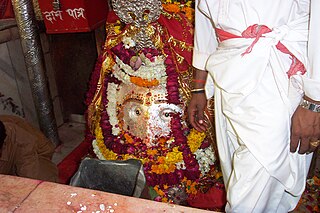
Kalkaji Mandir, is a Hindu Temple, dedicated to the Hindu Goddess Kali. It is situated in southern Delhi, in Kalkaji, India, a locality that has derived its name from the temple and is located opposite the Nehru Place and close to the Okhla railway station, Kalkaji Mandir metro station. Hindus believe that the image of the Goddess Kalka here is a self-manifested one.

Trilokpur is a Hindu temple site in Himachal Pradesh, India. It is located on an hillock about 24 km south-west of Nahan at an elevation of about 430 m. The temple is an amalgam of Indo-Persian styles of architecture.

Navaratri is an annual Hindu festival observed in honor of the goddess Durga, an aspect of Adi Parashakti, the supreme goddess. It spans over nine nights, first in the month of Chaitra, and again in the month of Ashvin (September–October). It is observed for different reasons and celebrated differently in various parts of the Hindu Indian cultural sphere. Theoretically, there are four seasonal Navaratris. However, in practice, it is the post-monsoon autumn festival called Sharada Navaratri. There are 2 Gupta Navaratris or "Secret Navaratris" as well, one starting on the Shukla Paksha Pratipada of the Magha Month and another starting in the Shukla Paksha Pratipada of Ashadha Month.
Deh is a Tehsil in Nagaur district of Rajasthan India
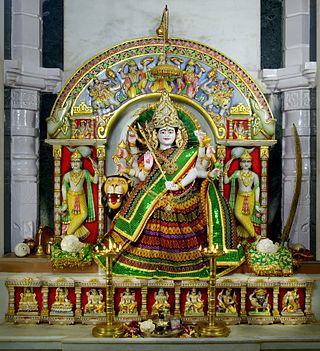
Ashapura Mata is an aspect of Devi, a Hindu goddess. She is one of the kuldevis of Kutch and Rajasthan, and the Jadeja clan of Gujarat, Chauhans and Patiyats inhabiting the western Indian provinces. She is a goddess regarded to fulfill the wishes of her adherents.
Sankata Devi Mandir, also known as Sankata Mata Mandir or simply Sankata Mandir; often referred to with prefix of Sri, is one of the most famous temples in the holy city of Varanasi. This temple has great religious importance in Hinduism and is dedicated to the goddess Sankata Devi. The Mandir was constructed in 18th century by King of Baroda. It is believed that this is the only temple in India dedicated to Sankata Devi.

Durgadi Fort is a fort located in Kalyan, near Mumbai in Maharashtra, India.
